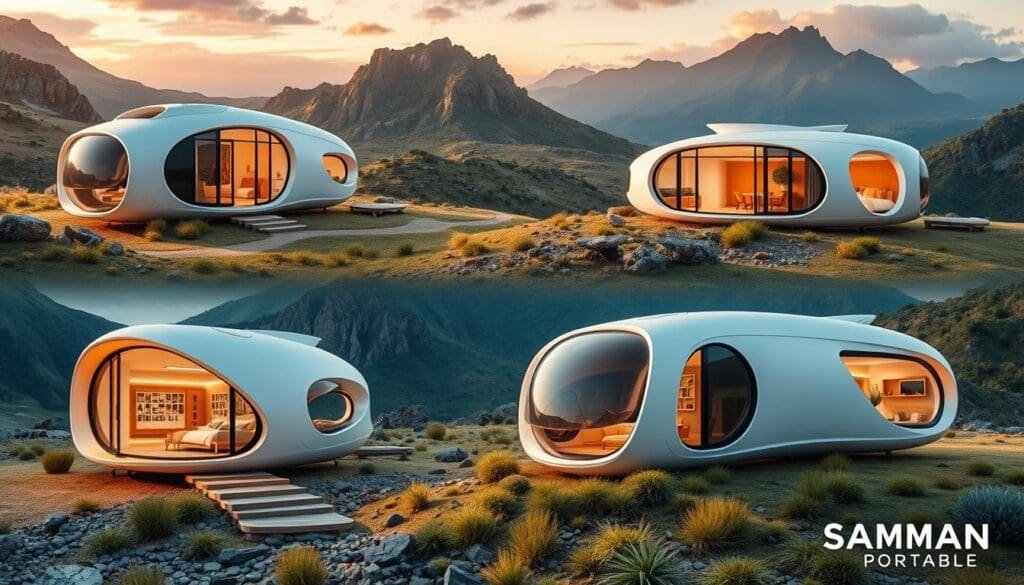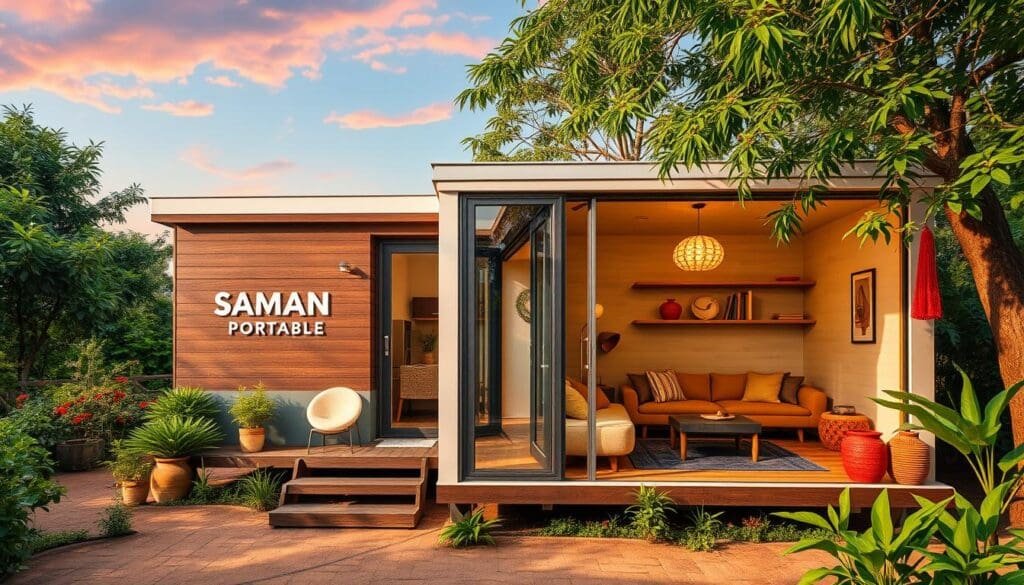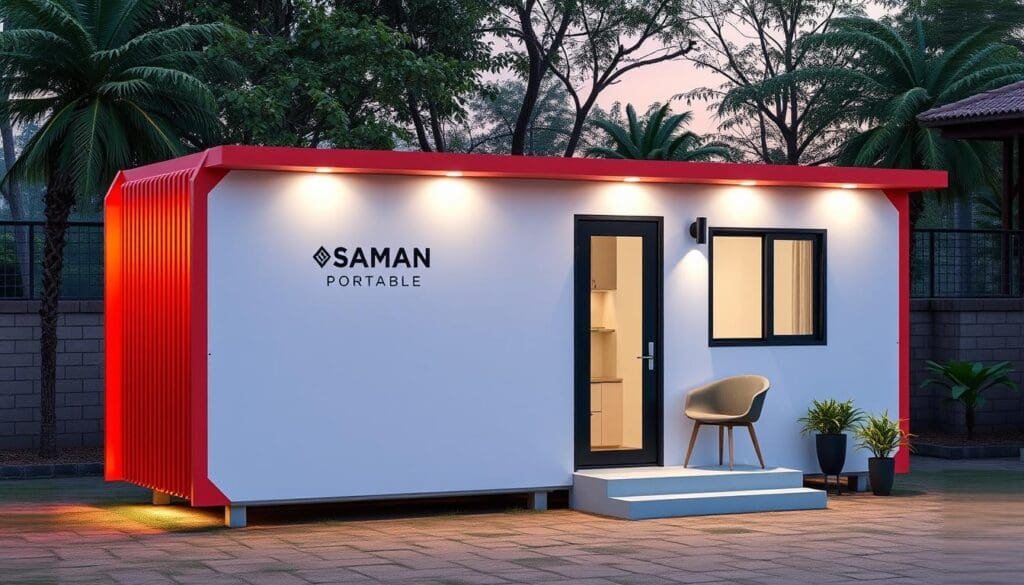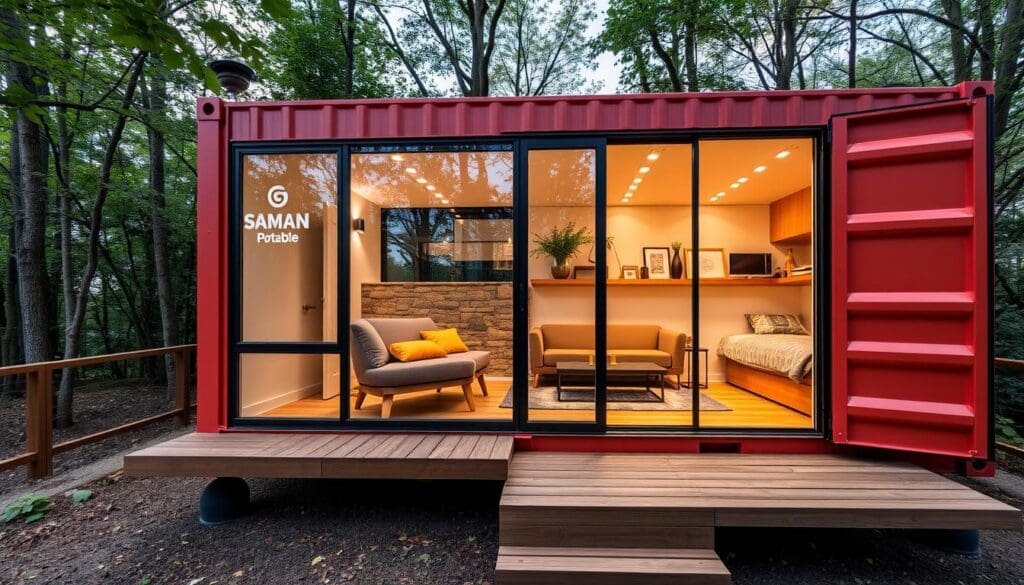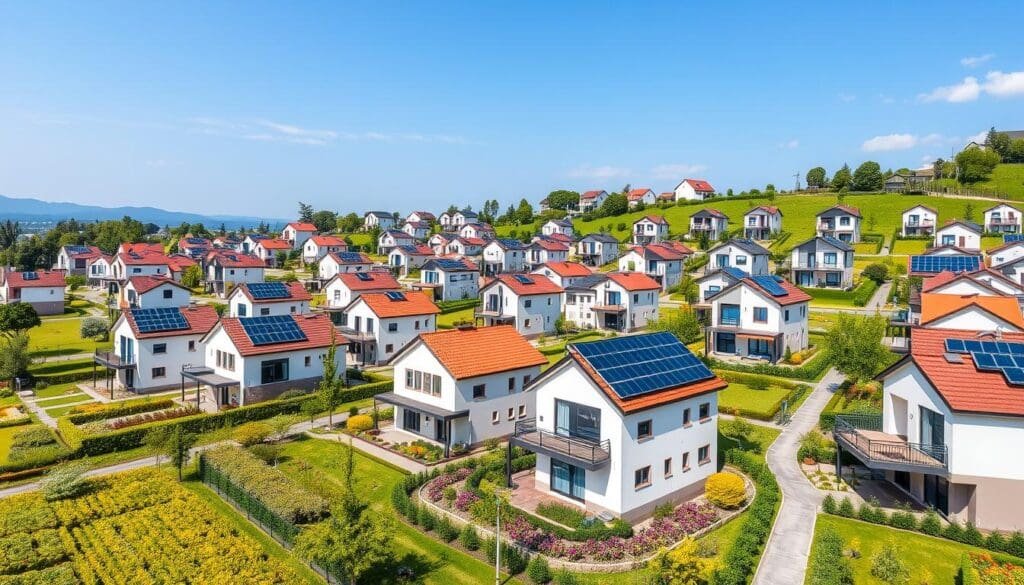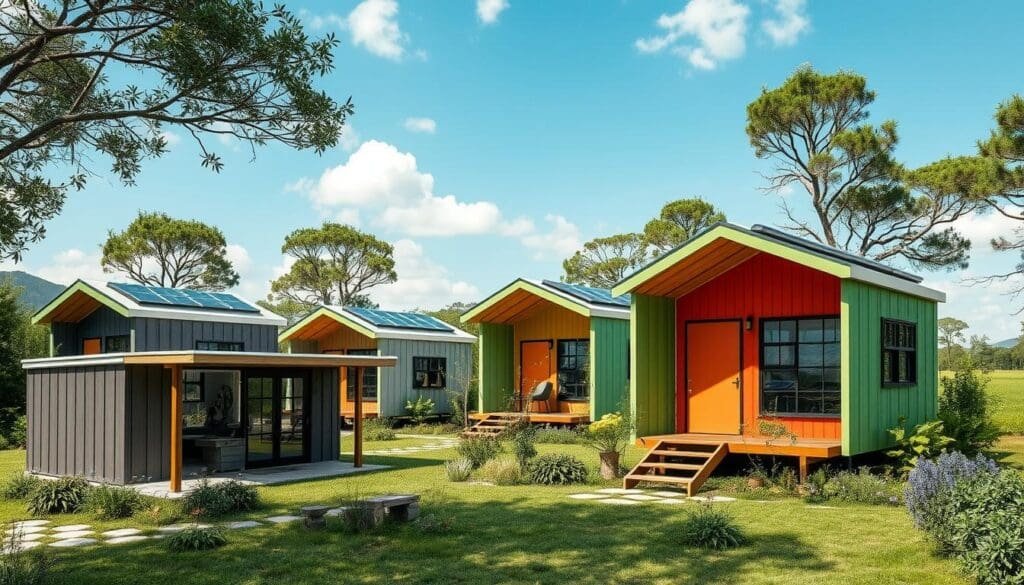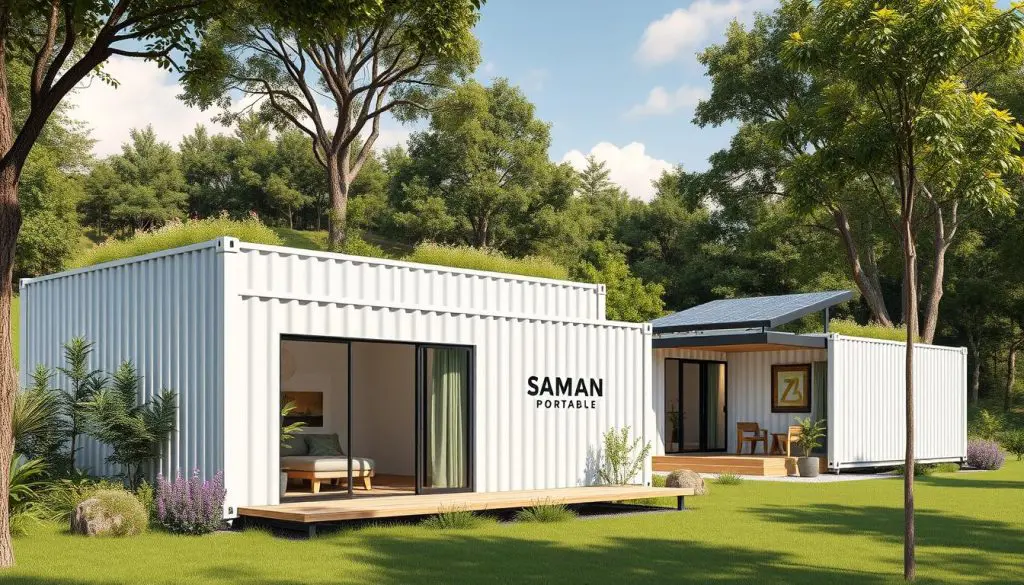Portable House Price: Affordable, Customizable & Energy-Efficient Home Options
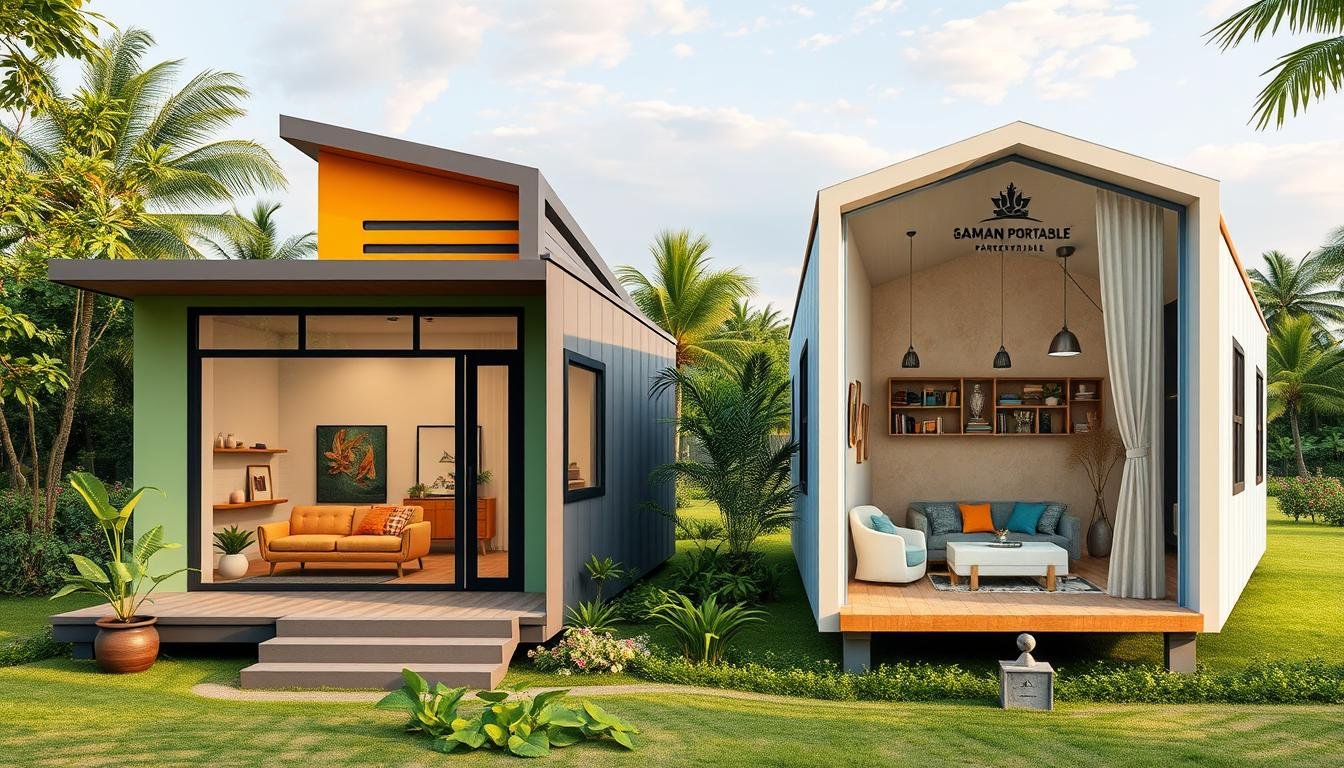
Are you tired of the usual housing problems? Looking for a flexible, affordable living option? Portable houses in India are changing the real estate scene. They offer new ways to own a home that challenge old ideas.
The market for portable houses in India is full of promise. It’s great for businesses and people wanting flexible spaces. Prices start at ₹2,00,000 for basic homes and go over ₹10,00,000 for luxury ones. These homes are both affordable and flexible.
Portable houses are more than just temporary homes. They show a new way to use space. They are affordable, can be customized, and save energy. Cities like Delhi, Mumbai, and Bangalore are seeing more people want these homes.
Key Takeaways
- Portable house prices range from ₹2,00,000 to ₹10,00,000
- Flexible designs meet diverse residential and commercial needs
- Significant cost savings compared to traditional construction
- Rapid installation with minimal on-site disruption
- Customizable options for personalized spaces
- Energy-efficient solutions reducing long-term utility expenses
- Sustainable alternative with reduced environmental impact
Understanding Modern Portable Housing Solutions
The way we think about housing is changing fast. Now, we have portable buildings that are flexible and affordable. These new solutions are making a big impact in India’s fast-paced market.
Portable structures are changing how we think about homes and workspaces. They offer everything from small cabins to portable classrooms. These new ideas are shaking up old ways of building.
Types of Portable Structures Available
- Basic portable cabins for residential use
- Luxury portable homes with advanced features
- Portable classrooms for educational institutions
- Modular office spaces for businesses
- Container-based living units
Key Benefits of Portable Housing
Portable buildings bring many benefits. Cost-effectiveness is a big one, with prices starting at ₹50,000 and going up to ₹10,00,000 for the fancy ones.
- Rapid deployment and construction
- Significant reduction in building time (20-50% faster)
- Material cost savings of 85-90%
- Environmentally sustainable design
- Customizable layouts and configurations
Market Overview and Trends
India’s prefabricated housing market is growing fast. With over 1,000 products available, it’s expected to hit ₹13.83 billion by 2024. Companies like Loom Crafts have built 250,000 square feet in 50+ cities.
The future of housing is about being adaptable, sustainable, and affordable. Portable buildings are leading the way, meeting the needs of today’s living spaces.
Evolution of Portable Building Technology
The world of portable buildings has changed a lot. What used to be simple temporary structures is now advanced, flexible spaces. Modular classrooms and portable solutions have changed how we design buildings.
Modern prefabrication has changed how we build. It lets us create flexible living and working areas.
Key advancements in portable building tech include:
- Precision manufacturing with digital control systems
- Advanced materials for better durability
- Sustainable designs in portable structures
- Smart energy-saving technologies
Prefab makers follow strict quality standards. They offer one-year material warranties and up to 10 years for design. Panels are made to be strong, with thicknesses of 60-100 mm.
The portable classroom market has seen big changes. Now, modular classrooms are not just useful but also look good. Cutting-edge technologies make these buildings strong in all kinds of weather.
When you buy a portable classroom, you get advanced features like:
- Integrated solar power systems
- High-performance insulation
- Quick assembly
- Custom design options
This change shows a move towards more flexible, green, and tech-savvy buildings. These meet the changing needs of education and workspaces.
Portable House Price: A Detailed Cost Analysis
Understanding the cost of portable houses is key for buyers. Buying mobile tiny homes needs careful budgeting and cost checking.

Looking at portable houses, several important costs come up. Here are the main financial things to think about:
Base Price Components
- Standard 1,000 sq. ft. home base price: ₹75,000
- 1,500 sq. ft. home base price: ₹112,500
- 2,000 sq. ft. home base price: ₹150,000
Additional Cost Considerations
More than the base price, many things affect the cost of mobile tiny homes:
- Customization costs: ₹750 to ₹11,250 per square foot
- Site preparation: ₹1,500 to ₹50,000
- Foundation installation: ₹4,000 to ₹12,000
- Utility connections: ₹5,000 to ₹30,000
- Permits and inspections: ₹1,000 to ₹5,000
Price Comparison with Traditional Housing
Portable houses are cheaper than traditional homes. Prefab homes cost 10-20% less, from ₹500 to ₹2,300 per square foot. This is because of the efficient manufacturing and less on-site work.
It’s wise to add 10-15% to your budget for surprises. This makes buying a home smoother and safer financially.
Container Homes as Cost-Effective Solutions
Container homes are changing the game for affordable housing in India. They are perfect for those on a budget. These portable cabins offer a new way to build homes.
Container homes are a smart financial choice. They cost between ₹1,500 to ₹3,000 per square foot. This is much cheaper than building a house the old way. It makes them great for many uses.
Key Cost Advantages
- Shipping container prices: ₹1 to ₹8 lakhs
- Used 40-foot containers starting at ₹1,50,000
- Interior modifications: ₹2,000 to ₹5,000 per square foot
- Rapid construction timeframe: 3-5 months
Container homes are designed to use space well. They can be up to 30% more space-efficient than regular homes. Sustainability meets practicality in these versatile spaces.
Environmental and Economic Benefits
- Reduces construction waste by approximately 75%
- Cuts construction costs by 30-50%
- Potential utility cost reduction of 40-70% with energy-efficient features
- Average lifespan of 25-30 years with proper maintenance
Looking for an affordable home or a flexible workspace? Container homes are the answer. They are cost-effective, sustainable, and stylish. Now, making your dream space is easier than ever.
Quality Standards and Construction Materials
When you look into portable housing, knowing about quality and materials is key. Durable Porta Cabins for Sale mix top engineering with smart design.
Durability Factors
The durability of portable cabins comes from a few important things:
- High-grade steel frameworks
- Corrosion-resistant materials
- Advanced welding techniques
- Precision manufacturing processes
Weather Resistance Features
Top Durable Porta Cabins for Sale have special weather tech:
- Waterproof exterior coatings
- Thermal insulation layers
- Wind-resistant structural designs
- UV-protected surface treatments
Safety Certifications
Good manufacturers follow strict safety standards. Quality control measures include tests for strength and structure. They also meet national building rules.
Prices for these quality cabins vary from ₹500 to ₹2,300 per square foot. This depends on the features and custom needs.
Customization Options and Interior Design

Turning your portable home into a space that’s all your own is thrilling. Prefab structures today offer a wide range of design and customization choices. This lets you make a home that shows off your style and meets your needs.
There are many ways to customize your home:
- Modular interior layouts
- Flexible room configurations
- Adaptable storage solutions
- Personalized finish selections
Designing your portable home’s interior is incredibly varied. Prefab Labor Colonies Manufacturer options let you pick from different materials, colors, and space-saving ideas. Prices for making changes usually fall between ₹2,000 to ₹5,000 per square foot. This makes it easy and budget-friendly to customize.
Some top ways to customize include:
- Maximizing compact living spaces
- Implementing multi-functional furniture
- Utilizing smart storage solutions
- Integrating energy-efficient design elements
Whether you want a cozy retreat or a big labor colony, these homes are very flexible. Today, prefab homes under ₹1,50,000 offer great chances to create homes that are truly yours.
Energy Efficiency Features and Sustainability
Contemporary container cafes and portable housing are changing sustainable living. They use new energy-saving technologies. These modern homes show great promise in cutting down on environmental harm while being cozy and flexible.
Sustainable design is key in modern portable homes. New technologies are changing how we save energy. Architects and designers are using many strategies to make eco-friendly places to live and work.
Solar Integration Options
Solar tech is vital in today’s container cafes and portable homes. Important solar features include:
- Roof-mounted photovoltaic panels
- Lightweight solar collectors
- Battery storage systems
- Grid-connected solar solutions
Advanced Insulation Technologies
New insulation methods are essential for keeping energy use low in portable homes. Structural insulated panels (SIPs) offer great heat control. They help:
- Keep heat in or out
- Save on energy
- Make interiors cozy
- Lower heating and cooling bills
Eco-friendly Materials
Modern portable homes use green materials for energy savings. Recycled steel, bamboo composites, and low-carbon cement are common. They help reduce construction’s carbon impact.
By focusing on energy efficiency and green design, these new homes offer a green way to live and work.
Transportation and Installation Considerations
Transporting a portable house needs careful planning and expertise. The trip from the factory to your place involves special logistics. This ensures your portable building arrives in top shape. Portable buildings are built strong to handle the journey.
Key transportation considerations include:
- Structural reinforcement during manufacturing
- Specialized shipping techniques
- Weight distribution calculations
- Route planning and possible obstacles
When looking at portable house prices, transport costs are key. Mobile homes are about 40% cheaper than traditional houses. Manufacturers use advanced methods to keep your investment safe during transport.
Installation for portable buildings involves several important steps:
- Site preparation assessment
- Foundation selection
- Utility connection planning
- Leveling and stabilization
Typical installation costs range from ₹20,000 to ₹25,000 for foundation work. Portable buildings are flexible, making them great for many places in India.
Your portable building’s safe transport relies on detailed planning, special gear, and expert handling. Knowing these steps helps ensure a smooth move to your new mobile home or office.
Site Preparation Requirements
Getting the site ready is key for setting up portable classrooms or small mobile cabins. The foundation and terrain check will affect how well your structure works. Doing it right can save you a lot of time and money later.
Foundation Options
There are different foundations for various terrain types for portable classrooms and small mobile cabins. Here are the main ones:
- Raft Foundations: Great for stable soil, used in about 30% of portable building setups
- Strip Foundations: Best for uneven land, making up about 45% of the market
- Pad Foundations: Good for tough soil like clay, used in 25% of installations
- Concrete Pier Foundations: Need at least two 50-pound concrete bags for support
Utility Connections
It’s important to plan utility connections for portable structures. You’ll need to work with local providers for water, electricity, and sewage. Check the site’s current setup and where you can connect before you start.
Terrain Assessment
A detailed terrain assessment includes several steps:
- Soil testing to see what it’s made of and how stable it is
- Checking drainage to avoid water problems
- Grading and leveling the site
- Ensuring the site is easy to get to for delivery trucks
Site preparation usually costs 10-15% of the total project. Spending time on a good terrain assessment can avoid future problems and make your portable structure last longer.
Regional Price Variations in India
In India, the prices for portable homes vary a lot from one place to another. The cost of modular classrooms and portable options changes a lot. This depends on where you are, how crowded the area is, and the local economy.
Several important factors affect the prices of portable structures in India:
- Urban center pricing (Delhi, Mumbai, Bangalore)
- Rural area cost variations
- Material availability
- Transportation expenses
- Local labor costs
In big cities like Mumbai and Bangalore, the prices for portable classrooms can be 30% higher. Urban areas need more complex designs and better infrastructure. This makes the costs go up.
In rural areas, you can find more affordable modular classrooms. Prices there are 20-25% lower than in cities. This is because of lower transport costs and labor expenses.
Here are some key points about portable housing prices in India:
- Base prices range from $50 to $100 per square foot
- Customization can add $10 to $150 per square foot
- Site preparation costs vary between $1,500 to $50,000
Knowing about these price differences helps buyers make better choices. It’s important when looking at portable housing options across India’s varied landscapes.
Financing Options and Payment Plans
Looking into financial options can make owning portable houses a reality. The mobile tiny homes market has many financing choices. These are designed to fit your budget and needs.
Loan Availability for Portable Homes
Getting a loan for a portable home is different from traditional housing. There are several good options available:
- VA loans provide up to 100% financing
- FHA loans require down payments as low as 3.5%
- Personal loans range from $25,000 to $100,000
- Chattel loans are for mobile homes
Loan Terms and Considerations
It’s important to know the details of your loan when buying mobile tiny homes. Key points to consider are:
- Loan amounts vary by home type
- Loan terms are usually 15-30 years
- Interest rates depend on your credit score
- Down payments can start at 3%
Insurance Strategies
It’s vital to protect your investment with the right insurance. Specialized mobile home insurance is designed for portable homes.
With traditional homes costing over $412,000 and manufactured homes at $127,250, portable houses are a more affordable choice for those on a budget.
Maintenance Costs and Long-term Value
Understanding the long-term economic benefits of Portable Cabins with Interiors is key for smart investment. These structures offer big advantages in maintenance and keeping value compared to traditional housing.
Smart Container Offices and portable cabins save money for those watching their budget. The maintenance costs are lower for several reasons:
- Standardized construction materials
- Modular design for easy repairs
- Less wear and tear than regular buildings
- Durable prefabricated parts
When looking at the financial side of portable housing in Tamil Nadu, keep these maintenance cost tips in mind:
- Entry-level container homes start around ₹2,00,000
- Mid-range options range from ₹5,00,000 to ₹12,00,000
- Premium Portable Cabins with Interiors cost above ₹12,00,000
Investing in Smart Container Offices offers long-term value with lower maintenance costs and flexible design. Prefabricated structures can save up to 30% compared to traditional building methods.
By taking proactive maintenance steps, you can make your portable cabin last longer. This ensures it works well and keeps its value over time.
Smart Features and Modern Amenities
The future of living is here with smart portable homes. Durable porta cabins are now more than just structures. They are advanced living spaces with the latest technology.
These homes come with smart features that change how you live. They make your life more comfortable, efficient, and green.
Your portable home can have advanced tech. This includes:
- Self-optimizing home management systems
- Energy-efficient appliances
- Integrated IoT connectivity
- Remote monitoring capabilities
Modern porta cabins for sale have smart platforms like DveleIQ. They track your home’s performance in real-time. You get insights on energy use, temperature, and security.
Technology in portable homes offers many benefits:
- More convenience in your daily life
- Less energy use
- Better home security
- Customized living experiences
Prices for these smart homes range from ₹750 to ₹1,599 per square foot. They are a smart investment in comfort and technology. The future of housing is here, and it’s smart, compact, and tailored to you.
Regulations and Permits
Understanding Indian laws for portable housing is key. As a Prefab Labor Colonies Manufacturer, knowing specific rules is essential. These rules cover how to install and run modular structures.
Planning your portable housing project means facing several legal hurdles. The rules for prefabricated buildings involve many approvals and documents.
Key Legal Requirements
- Obtain necessary municipal building permits
- Comply with local zoning regulations
- Secure structural safety certifications
- Complete environmental impact assessments
Zoning Considerations
Zoning laws can greatly affect your Prefab Labor Colonies Manufacturer project. India’s different areas have their own rules for portable buildings. These might include:
- Land use restrictions
- Minimum distance requirements from existing structures
- Height and dimension limitations
- Utility connection protocols
Pro tip: Always check with local authorities before starting your prefab housing project. This ensures you follow local rules.
Documentation and Inspection Process
For a successful portable housing project, you need detailed documents. Make sure to have:
- Detailed architectural plans
- Structural engineering reports
- Material compliance certificates
- Land ownership and usage rights
Knowing these rules helps you move your project forward smoothly. It also reduces legal issues.
Market Comparison and Competitive Analysis

The portable housing market in India is changing fast. The prefabricated housing market is expected to hit USD 30.93 billion by 2029. This growth is making Contemporary Container Cafes more popular.
Key market insights show important advantages:
- Faster construction times than traditional methods
- Lower initial costs
- High customization for homes and businesses
- More sustainable and less harmful to the environment
Contemporary Container Cafes are a big step in modular design. They offer businesses quick, affordable solutions. The data shows more people want buildings that can change and adapt.
Looking at the competition, we see a few key points:
- New makers are bringing fresh designs to the table
- Using technology is becoming a big difference-maker
- Being able to grow and move is a big plus
Investing in portable structures like Contemporary Container Cafes could pay off big time. You’ll save on construction time and upkeep costs.
Conclusion
Looking into portable homes is a big step towards changing how we live in India. Prices for these homes range from ₹14,00,000 to ₹23,00,000. They offer a new way to build homes that are both affordable and flexible.
Buying a portable home is more than just getting a place to stay. These homes are smart and cost-effective. They can be made in many styles, making them a great choice for those who want a home that’s both useful and stylish.
The future of homes is about being green and efficient. Portable homes use materials that are good for the planet and save energy. They can be set up fast, making them perfect for many needs, like small homes or offices.
As the market grows, portable home prices will get even better. These homes are made with the latest technology, need less upkeep, and can be put up quickly. They show a new way of living in India’s fast-changing housing market.
FAQ
What is the average price range for a portable house?
The cost of a portable house varies a lot. It depends on size, features, and how customized it is. Prices range from ,000 to 0,000. The final cost can change based on square footage, materials, and extra features.
Smaller mobile cabins are at the lower end. But, if you want a fully customized home with advanced features, prices can go up.
How do portable houses compare to traditional construction in terms of cost?
Portable houses are 10-30% cheaper than building a house the traditional way. They save on labor, construction time, and materials. You also save on site prep and avoid some of the complex costs of traditional building.
Are portable houses durable and weather-resistant?
Yes, modern portable houses are very durable. They are made with strong materials and techniques. They can handle different weather conditions well.
Many portable houses have safety certifications. With proper care, they can last 20-30 years.
Can I customize a portable house to meet my specific needs?
Absolutely! You can customize a portable house a lot. You can change the inside and outside, and add special features. Whether you want a small cabin or a fancy office, there are flexible options to fit your needs and style.
What are the energy efficiency features of portable houses?
Portable houses are very energy efficient. They use solar power, insulation, and eco-friendly materials. They can use up to 40% less energy than regular houses, making them good for the environment and your wallet.
How long does it take to transport and install a portable house?
It’s much faster to move and set up a portable house than a regular one. It usually takes 1-3 days, depending on size and complexity. The process is quick, with special transport and foundation setup, to minimize disruption.
What financing options are available for portable houses?
There are many ways to finance a portable house. You can get loans just for prefabricated homes, personal loans, or financing from the manufacturer. Some lenders have special mortgage options for these homes. Many manufacturers also offer payment plans to help make it easier to buy.
Are there legal considerations when installing a portable house?
Yes, you need to think about the law. You’ll have to check zoning rules, get permits, and follow local building codes. The rules can vary, so it’s important to talk to local authorities and maybe get help from a professional who knows the rules for portable homes in your area.
How do container homes differ from traditional portable houses?
Container homes are made from shipping containers. They are often cheaper and very durable. Unlike traditional portable houses, container homes are made from recycled materials, appealing to those who like industrial or minimalist designs.
What maintenance is required for a portable house?
Portable houses need very little maintenance. Just regular checks, sealing, and cleaning are needed. The materials used in modern portable houses are made to last long and resist wear and tear, saving you money and effort in the long run.
 Container Cafe
Container Cafe

















































































